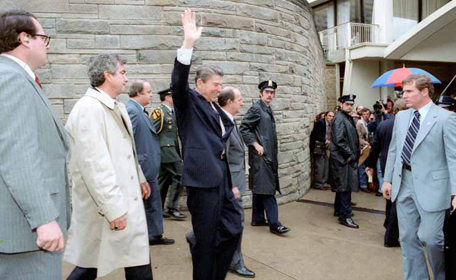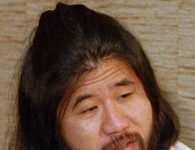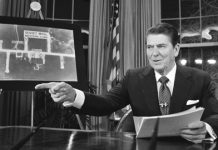On March 30, 1981, President Ronald Reagan was shot in the chest by John Hinckley Jr., a college dropout hoping to impress actress Jodie Foster. Hinckley shot three others during the assassination attempt, including Press Secretary James Brady, who was left permanently paralyzed.
Reagan Survives Assassination Attempt
Ronald Reagan had been in office for just 70 days when he traveled to the Washington Hilton to speak to union representatives. After the speech, as Reagan walked out of the Hilton to his limousine, John Hinckley Jr. stepped forward from a crowd and fired six shots with a .22-caliber gun.
The first shot hit Press Secretary James Brady in the head. Ensuing shots hit police officer Thomas Delahanty and a Secret Service Agent Timothy McCarthy. The sixth shot ricocheted off the limousine and struck Reagan in the chest, missing his heart by just an inch.
Reagan was shoved into the limousine by Secret Service Agent Jerry Parr and taken to George Washington University Hospital. Reagan recounted in his autobiography, “An American Life,” that he did not know he had been shot; he believed that he had broken a rib when Parr tackled him during the shooting. Reagan managed to walk out of the limo and into the hospital before collapsing.
Reagan underwent emergency surgery to remove the bullet and repair a damaged lung. The severity of his condition was not known to the public and Reagan maintained a sense of humor throughout the life-threatening ordeal. When his wife Nancy arrived to see him, he remarked, “Honey, I forgot to duck.” He also told a doctor, “I hope you’re a Republican,” to which the doctor replied, “Today, Mr. President, we’re all Republicans.”
While Reagan recovered from his injuries at Camp David, he called in to the White House Correspondent’s dinner on April 25 to deliver his remarks. Just months later he addressed Congress to promote his economic plan and received a rapturous ovation. The public image of Reagan became stronger than ever; concerns about the 70-year-old’s vitality faded and he earned “his reputation for toughness, humility, and strength,” writes the Miller Center for Public Affairs.
But according to biographer Edmund Morris, the shooting weakened Reagan considerably. “His thoughts became slower, his speech became slower, he deliberated more. He hesitated more when he spoke. He lost his quickness,” he told PBS. “And for the rest of the presidency, it was a very, very slow and steady mental and physical decline.”
The assassination attempt was captured on video.
Sources in this Story
- University of Virginia: Miller Center for Public Affairs: President Reagan Shot—March 30, 1981
- PBS: The Presidents: Reagan
- The American Presidency Project: Remarks by Telephone at the Annual Dinner of the White House Correspondents Association
- Association for Diplomatic Studies and Training: Al Haig and the Reagan Assassination Attempt—“I’m in Charge Here”
- University of Missouri-Kansas City School of Law: The John Hinckley Trial
- Letters of Note: I may be killed in my attempt to get Reagan
- The Atlantic: The Day Reagan Was Shot
- NBC News: John Hinckley Freed From Mental Hospital 35 Years After Reagan Assassination Attempt
- Washington Post: Medical Examiner Rules James Brady’s Death a Homicide
- The Brady Center to Prevent Gun Violence: Jim and Sarah Brady
Alexander Haig and the Confusion Over Succession
As the president underwent surgery, Secretary of State Alexander Haig appeared to believe that, with the president in the hospital and Vice President George Bush temporarily out of touch, he assumed the powers of the president. In fact, under the 25th Amendment, Haig was fourth in the chain of succession behind Bush, Speaker of the House Tip O’Neill and President Pro Tempore Strom Thurmond.
The confusion among Cabinet members over who was in charge is illustrated in tapes released in 2001 by National Security Adviser Richard Allen. After the meeting, Haig went before a press conference and declared that he was “in control.” He was widely ridiculed for the statement, which contributed to a career decline.
Hinckley’s Motivation
John Hinckley Jr. was a depressed and mentally unstable loner who got the idea to assassinate the president from the movie “Taxi Driver,” which he watched 15 times in the years leading up to his assassination attempt.
In the movie, protagonist Travis Bickle (Robert De Niro) plots to gain the attention of a political campaign worker (Cybil Sheppard) by trying to kill a candidate she works for. His assassination attempt fails, but he becomes a hero and earns Sheppard’s respect when he kills the pimp of a 12-year-old prostitute played by Jodie Foster.
“Hinckley began to emulate Bickle, accumulating an arsenal of weapons and fixating on Jodie Foster,” writes PBS. “Foster would not be his target, but his inspiration: To ‘rescue’ her, he began to stalk Jimmy Carter during the 1979 presidential campaign.”
He also began hanging around Yale University, where Foster was a student. After failing to gain her attention through letters and phone calls, he decided to needed to carry out a noteworthy act to win her affection.
The night before he shot Reagan, Hinckley wrote a letter to Foster: “I will admit to you that the reason I’m going ahead with this attempt now is because I just cannot wait any longer to impress you. I’ve got to do something now to make you understand, in no uncertain terms, that I am doing all of this for your sake!”
Hinckley finally met Foster when she testified at his trial. Foster made no eye contact with Hinckley and said that she had no relationship with him, prompting Hinckley to shout, “I’ll get you, Foster!”
Presidential Assassinations
- 1865: Abraham Lincoln
- 1881: James Garfield
- 1901: William McKinley
- 1950: Harry Truman (Failed)
- 1963: John F. Kennedy
- 1975: Gerald Ford (Failed)
Hinckley would be found not guilty by insanity on 13 criminal counts. The verdict sparked a national uproar and led to legislation making it more difficult to be acquitted on the insanity defense.
Hinckley was placed in a mental hospital. After three decades of treatment and gradually being allowed greater and greater freedom, Hinckley was released from the hospital in 2016 and allowed to live with his mother in Williamsburg, Virginia.
James Brady and the Brady Bill
Although the president recovered from the shooting, his press secretary, James Brady, was shot in the head and barely survived. He was permanently paralyzed on his left side.
Brady and his wife Sarah devoted themselves to campaigning for stricter gun control laws; after 10 years of work, they were able to get President Bill Clinton to pass the Brady Bill in 1993. The law requires a five-day waiting period and a background check before the purchase of a gun.
James Brady died in August 2014 at the age of 73. His death was ruled a homicide, due to the injuries he sustained in the shooting. Sarah Brady died in 2015. The advocacy the started continues today at the Brady Campaign to Prevent Gun Violence.
Biography: Ronald Reagan
Read findingDulcinea’s profile of Ronald Reagan.
In 2012, we published this article about this historic event on the New York Times Learning Network. This article connected the event to current issues and offered reflection questions to help the reader think about its relevance today.











